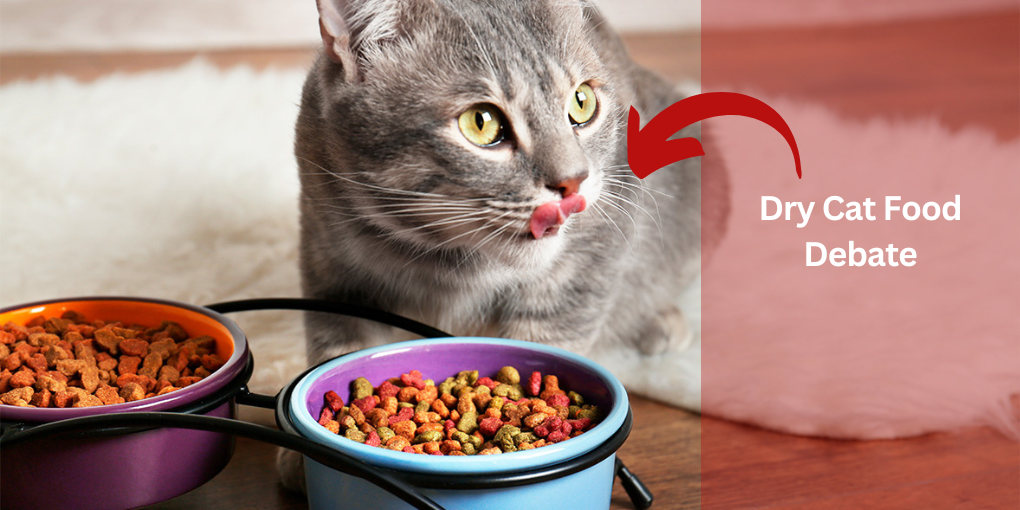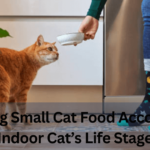The debate on what is the best food for an indoor cat between dry and wet food has been ongoing for years.

Both types of food have their positives and negatives. However, it is essential to analyze what each type of food offers and the necessary requirements for your cat.
In this blog section, we will examine dry and wet cat food to establish which is the best for indoor cats.
The benefits of dry cat food For Indoor Cat
The debate over feeding indoor cats dry versus wet food is longstanding and a topic that many cat owners remain divided on.
It’s important to note that both types of food have their advantages and disadvantages, which is why it’s important to understand what your cat’s needs are before making a decision.
One advantage of dry cat food is that it tends to be cheaper than wet food. It’s more affordable to produce and store, so it’s an option that can save owners some money.
Dry food can also be left out all day without spoiling, making it an easier option for those with a busy schedule.
Additionally, dry food is known to help scrape plaque and tartar off the teeth as cats chew, which can help keep their mouths healthy.
Another benefit of dry cat food is that it has a longer shelf life than wet food. Unlike wet food, which can become contaminated easily if left out too long, dry food can remain fresh for longer periods of time if stored properly.
This makes it a convenient option for pet owners who buy in bulk and want to have food on hand without worrying about spoilage.
In addition, dry food is more nutritionally complete than ever before.
Although some low-quality dry food brands still exist, there are now many high-quality options available that offer optimal nutrition for cats. These options include both kibble and freeze-dried raw food diets.
However, it’s important to note that not all cats can thrive on a dry food diet.
Some cats have trouble digesting dry food, which can lead to dehydration and urinary tract problems.
In these cases, owners will want to consider a wet food diet or feeding a combination of the two to ensure their cat is getting the nutrients they need.
The drawbacks of dry cat food
- Dehydration – One of the most significant issues with dry cat food is that it can lead to dehydration. Cats are known to have a low thirst drive, and they typically obtain most of their water through their diet. Dry cat food, which has a moisture content of only 10-12%, doesn’t provide enough water to cats. This can lead to urinary tract issues, kidney problems, and other health concerns.
- High Carbohydrate Content – Most dry cat food brands have a higher carbohydrate content than wet food. This is because carbohydrates are needed to make the kibble, and they also act as binders to give the food its shape. However, a high-carbohydrate diet is not ideal for cats, as their digestive systems are designed to break down protein and fat more efficiently.
- Dental Problems – Many pet owners believe that dry cat food helps keep their cat’s teeth clean, but this is not necessarily true. While chewing on kibble can help scrape off some tartar, cats still need regular dental care to avoid dental problems. Additionally, dry cat food can be hard on a cat’s teeth, especially as they get older and their teeth become more fragile.
- Palatability – Cats are known for being picky eaters, and some cats may not find dry cat food as palatable as wet food. The lack of moisture and the texture of the kibble can be unappetizing to some cats, which can result in a lack of appetite and weight loss.
- Allergies and Sensitivities – Some cats may also be sensitive or allergic to the ingredients used in dry cat food. Corn, wheat, and soy are common allergens found in many dry cat food brands. Additionally, some cats may have trouble digesting the high amount of carbohydrates found in dry food, leading to gastrointestinal issues.
The benefits of wet cat food
One of the main benefits of wet cat food is its hydration factor. Cats are notoriously bad at drinking water, often leading to chronic dehydration, which can cause serious health problems.
Wet food has a high moisture content, which helps to keep cats hydrated and can prevent kidney disease and other health problems.
Another advantage of wet cat food is its texture. Many cats prefer the taste and texture of wet food to dry kibble, making it easier to get them to eat. Plus, if your cat has dental problems or is missing teeth, wet food can be much easier to chew and digest.
Wet food is also rich in protein and nutrients, which are essential for your cat’s overall health.
Most wet cat food contains high-quality animal protein, which helps to maintain lean muscle mass and keep your cat’s coat healthy and shiny.
This is because wet food is closer to a cat’s natural diet, which would consist of prey animals, rich in moisture and nutrients.
One of the biggest concerns pet owners may have about feeding their cat wet food is the cost, as it is generally more expensive than dry food.
However, there are ways to cut costs, such as buying in bulk or looking for discounts.
The benefits of feeding your cat wet food may outweigh the cost in terms of their overall health and well-being.
The drawbacks of wet cat food
Wet cat food has its benefits, such as its high moisture content, which can be beneficial to a cat’s kidney health. However, there are also some drawbacks to consider:
– Tarter build-up: Wet food can cause tartar build-up on a cat’s teeth, which can lead to dental problems.
– Short shelf-life: Once opened, wet food doesn’t have a long shelf-life, making it harder to store and keep for longer.
– Cost: Wet food can be more expensive than dry food, which might not be feasible for those on a budget.
– Spoilage: Leftover wet food can spoil more quickly than dry food and can attract insects or rodents.
– Digestive Problems: Some cats may experience digestive problems if they consume wet food too quickly or eat too much at one time.
Choosing the right food for your cat
As a cat owner, it’s always crucial to make informed decisions regarding your cat’s diet.
One of the most debated topics among cat owners is whether dry or wet food is the better choice for their cats.
Although both types of food have their benefits, there are certain factors you should consider before choosing the right food for your cat.
Here are some points to consider when choosing the right food for your cat:
- Nutritional Value: A cat’s diet should include protein, fat, and essential amino acids. Both dry and wet cat food can fulfill nutritional requirements, but it’s essential to ensure that the ingredients are of high quality and meet the minimum nutritional standards required.
- Moisture Content: Cats require a sufficient amount of moisture intake to maintain their health. Wet cat food contains more moisture than dry food, which keeps your cat hydrated and can prevent urinary tract problems and dehydration.
- Convenience: Dry cat food is more convenient for pet owners as it can be left out for long periods without going bad. On the other hand, wet cat food needs to be refrigerated or consumed within a few hours once it’s opened.
- Budget: The cost of both types of cat food can differ significantly. Wet cat food is generally more expensive than dry cat food, which can impact your budget.
- Personal Preference: Finally, every cat has their own preferences. Some prefer dry food, while others love wet food.
The Importance of balanced nutrition
Balanced nutrition is crucial not only for human beings but also for our feline friends.
An indoor cat’s balanced diet must include a mix of protein, vitamins, and minerals.
It is essential to incorporate healthy food options that meet their nutritional requirements and prevent health problems.
Therefore, when choosing between dry and wet food, it is vital to consider the nutrients present in them. Here are a few points to consider concerning the importance of balanced nutrition:
- Proteins: Proteins are essential for cats as they help maintain muscle and tissue health. They should make up at least 30% of their diet to keep them in perfect shape.
- Vitamins and minerals: Vitamins and minerals are crucial for cats to stay energized and healthy. It helps strengthen their immune system and helps them fight against diseases.
- Lipids: Lipids or fats are the sources of energy for cats. It is crucial to incorporate healthy fats in their diet.
- Water: Adequate water intake is necessary for cats to prevent dehydration. Indoor cats have a lower water intake, which makes wet food an excellent option.
Understanding your cat’s dietary needs
As a cat owner, it is essential to understand your feline friend’s dietary needs.
Feeding your cat a well-balanced, nutritious diet is crucial for their overall health and wellbeing.
Here are some important factors to consider when choosing the right food for your cat:
Protein Requirements
Cats are obligate carnivores, meaning they require a diet high in animal-based protein.
Ideally, the protein in your cat’s food should come from sources like chicken, beef, fish, and eggs.
Most commercial cat foods meet or exceed cats’ protein requirements, but it is always a good idea to check the ingredients list to ensure high-quality protein sources are included.
Carbohydrates
Cats do not have a dietary need for carbohydrates, and in excess, carbohydrates can cause health problems like obesity and diabetes in cats.
However, some carbohydrates, like fruits and vegetables, can be beneficial for cats as they are a source of fiber, which can help with digestion.
Avoid high-carbohydrate fillers like corn, wheat, and soy, which provide little to no nutritional benefit for your cat.
Sufficient Vitamins and Minerals
The right balance of vitamins and minerals is equally important for your cat’s health.
A well-balanced diet will provide all the essential vitamins and minerals your feline friend needs.
These include vitamins A, C, D, E, and B-complex vitamins, as well as calcium, phosphorus, and potassium.
Avoid Artificial Additives
Many commercial cat foods contain artificial additives, like preservatives, flavors, and colors, which can be harmful to your cat’s health.
Choose cat food brands that use natural ingredients and avoid food that contains chemical preservatives like BHA, BHT, and ethoxyquin.
Conclusion
In summary, both dry and wet cat food have their unique advantages and disadvantages.
The decision on which one to choose ultimately depends on your cat’s individual needs.
However, if you’re looking for the best option for an indoor cat, wet cat food is an excellent choice for its high-moisture content, which helps keep your cat hydrated and healthy.
Combining wet and dry cat foods is another way to provide a healthy and balanced diet for your indoor cat.
– Ensure you purchase high-quality cat food for your cat.
– Always offer your cat fresh and clean water to prevent dehydration.
– Make adjustments to cater to your cat’s individual needs.
– Consider consulting with a veterinarian about your pet’s food choices for long-term health.
– Be mindful of the appropriate amount of food to prevent obesity.

Patricia White is a pet enthusiast. With 10 years of experience in the pet industry, she brings a wealth of knowledge and expertise to MeToPet. She is honored to be a part of the MTP team and is dedicated to sharing her passion for pets with our readers.









